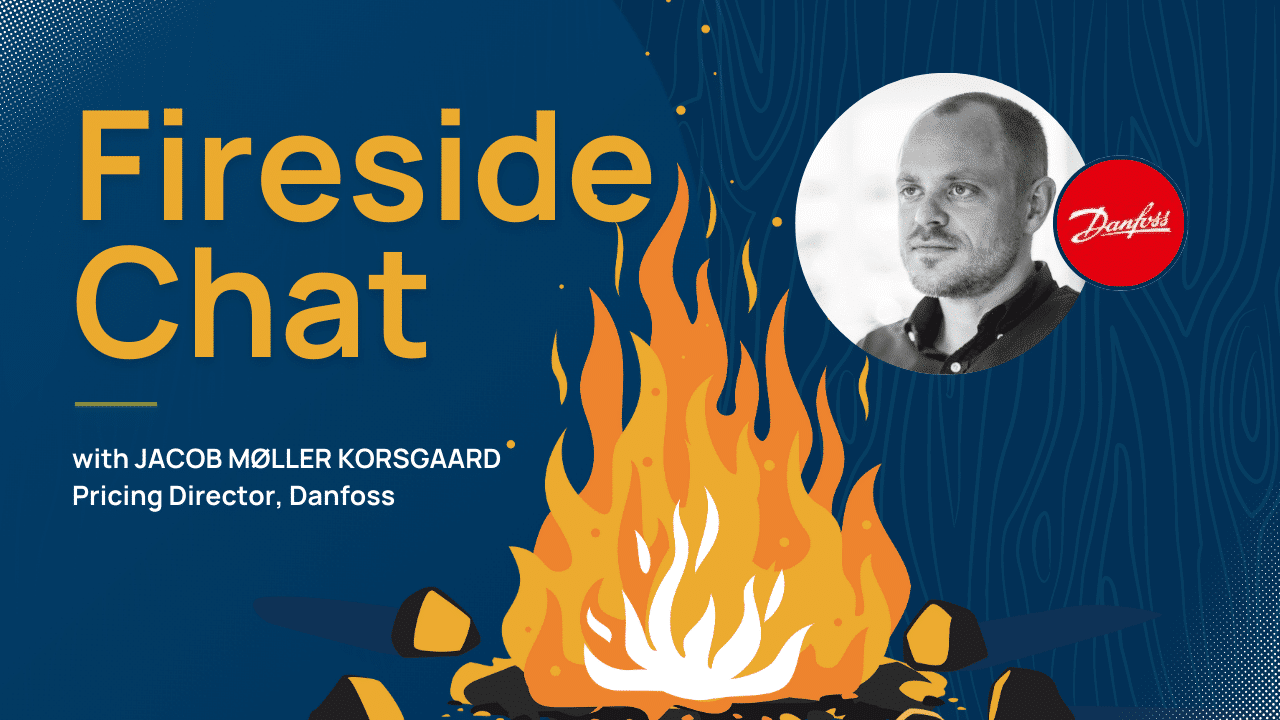
In this Fireside Chat from Vendavo’s Growth + Profitability Summit 2023 in Stockholm, Thrudur Starradottir, Customer Success Manager at Vendavo, talks with Jacob Møller Korsgaard, Pricing Director at Danfoss, about his advice for dealing with organizational silos, the importance of having a common language and framework, and why being able to showcase the value of pricing projects to stakeholders is key.
Thrudur Starradottir: I’m Thrudur Starradottir, Customer Success Manager here at Vendavo, and I am here with my guest.
Jacob Møller Korsgaard: Hi, my name is Jacob Møller Korsgaard, I’m happy to be here.
Starradottir: I’m very happy to have you here, and you are from Danfoss. So, we are here in Stockholm at Vendavo’s Growth + Profitability Summit and you were just now one of the panelists on “Pricing Without Walls.” So, what advice do you have for companies dealing with silos in their organization?
Møller Korsgaard: It’s very important that we have a common language. So, working with a pricing excellence framework has been really beneficial for Danfoss because if you’re not talking the same language, then it’s difficult to break down the silos. So, a common language, and also, what Bruno also mentioned, [explaining] “What’s in it for me?” It’s important to show people the benefits of what it is that we’re doing. That way we are pulling in the same direction and not staying in our silos.
Starradottir: Where did that framework kind of come from so that you could establish the common language?
Møller Korsgaard: So, we decided to have what we call a Danfoss Pricing Excellence Program, and there we defined a framework. So, in very basic terms, what do we mean when we say a list price? What is it? What is a discount? How many do we have, and how do we segment customers? All these terminologies that we talk about in pricing, we have at least a common framework for how to do it, and then we can deviate a little bit. But as long as we have something that we can explain and people understand – “Okay, this is what he’s talking about” – then it makes it much easier.
Starradottir: Absolutely. All right. So how do you go about achieving pricing alignment across the organization of Danfoss?
Møller Korsgaard: So that goes back to the framework. Once you have the framework, then you can start to report on it. You can integrate into the system because you know what conditions to pick from SAP, for example. So then, suddenly you can integrate systems, create KPI reports, and, again, having that shared understanding between the different broad lines that I’m working with, but also between the different segments so you can communicate online – also to the general public that we have thousands of people that are interested in pricing and needs to be informed. The framework also has to be relatively simple so people can understand it even though they don’t work with pricing every day.
Starradottir: Right. Absolutely. So, do you feel like it has been a challenge? It’s not like you want to make everyone in the organization a pricer, but do you feel like that has been a challenge for you to get people to really understand the concepts and what’s being discussed?
Møller Korsgaard: For sure, for sure. I think I have been on stage many times trying to explain the concept, the different phases we have, and all the technicalities that I think are super interesting and important. But even now, after three years, I had a discussion just on Friday with a very important stakeholder and I found out in the end of our talk that he didn’t really understand the concept of having a list price and what it really meant. So it was, again, very back to the basics. So you can talk about the nice pricing things and AI and all that, but you need to get the basics right.
Starradottir: Absolutely. No, it’s a super important first step really to get that alignment. So, what is Danfoss’s biggest pricing challenge this year and how are you working to solve that?
Møller Korsgaard: We’re coming out of a very volatile market with price increases through the roof and results that have never been better probably for many companies. Now we’re coming into probably a recession where things are slowing down, and how do we maneuver in that? It’s actually much more difficult than just raising the price if everyone sees a need for it. Now we still have inflation, but we also have some raw materials coming down, so the communications toward customers are very, very difficult right now – to defend pricing and also internally in the organization.
Starradottir: Yeah.
Møller Korsgaard: So, it’s a new challenge, but I think it’s much more difficult than it was two years ago where everyone was in panic but everyone understood the direction. Now that’s a bit more unclear. So, it’s more important to have systems and solutions that are integrated to manage that process as we maybe go down again.
Starradottir: Exactly. Yeah. So, when this big change comes that you at least know where it is. It’s not in Excel sheets across the company and no one knows where we’re aligned and so on. So, what trends do you see impacting pricing or selling strategies in the near future for you?
Møller Korsgaard: So, everyone is talking about AI and chatbots, so how can we use that in pricing? It’s clear we have a lot of complexity, so it would be beneficial that we have systems that can help us crunch these numbers and come with recommendations. That would be something that I see for me that we could do. We have struggled a lot to create the product strategy through very advanced formulas. If we can take a bit of the workload out of that, but still having the confidence that it actually matches our strategy, that could be one thing. And then, on the customer side, of course we have, I don’t know, 100,000 customers globally or something, so how can we have help in segmenting them?
Starradottir: Right.
Møller Korsgaard: Now we have relatively basic segmentation, which is a good starting point, but if we want to do more advanced I think we need a system to help us, too.
Starradottir: Yeah, exactly. And are you looking already at some AI solutions, or is that something that’s just up and coming?
Møller Korsgaard: We’re talking a lot. I think we’re not ready just yet. I think it’s important to get the basics right as we start talking about it. Once we’re there, then we can build.
Starradottir: Yeah, absolutely. All right. Thank you for being here with us. It was a pleasure talking to you.
Møller Korsgaard: Thank you for the invite.
